How To Get A Dragon Patronus
- "Four fully grown, enormous, vicious-looking dragons were rearing on their hind legs inside an enclosure fenced with thick planks of wood, roaring and snorting torrents of fire were shooting into the dark sky from their open, fanged mouths, fifty feet above the ground on their outstretched necks."
- — The dragons used in the Triwizard Tournament[src]
Dragons were giant winged, fire-breathing reptilian beasts. Widely regarded as terrifying yet awe-inspiring, they could be found all over the world and were frequently referred to in Asian and medieval European folklore.[1]
Able to fly and breathe fire through their nostrils and mouths, they were one of the most dangerous and hardest to conceal creatures in the wizarding world. Their heartstring could be used as the core of the wand. The British Ministry of Magic classified them as XXXXX, known wizard killers that were impossible to train or domesticate. Despite how dangerous they were, there were people who were trained to work with them, called dragon keepers, or dragonologists. A wizard or witch who traded and sold dragon eggs (which was an illegal activity) was referred to as a dragon dealer.[1]
It was a possible, rare corporeal form of the Patronus Charm,[5]
Contents
- 1 Description
- 1.1 Early life
- 1.2 Social behaviour
- 2 History
- 3 Dragons in the wizarding world
- 3.1 Uses
- 3.2 Books
- 3.3 Spells that affected dragons
- 3.4 Dragon reserves
- 4 Known breeds
- 5 Behind the scenes
- 6 Appearances
- 7 Notes and references
Description
Early life
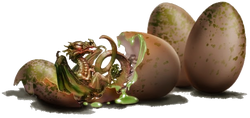
Hatching of a Common Welsh Green
Dragon mothers breathed fire on their eggs to keep them warm. They did not keep their eggs in nests.[6] Newly born dragons were referred to as chicks.[7] The dragon's first fire breaths, usually accompanied by thick grey smoke, appeared when the dragon was around six months old. However, the ability to fly was normally developed later, at around twelve months, and the dragon would not be fully mature until it was two years old and ready to live on its own.[8] Dragon Breeding for Pleasure and Profit stated that you were to feed a baby dragon a bucket of brandy mixed with chicken blood every half hour.[2] This apparently served as a replacement for dragon milk.[9]
Not much is known about dragon behaviour, however it seemed that, at least with the Chinese Fireball, females were generally larger and dominant over males. Fantastic Beasts and Where to Find Them stated that sometimes females ousted males from their territories, at least with the Antipodean Opaleye. It also stated that Fireballs were unusual in that they were willing to share territory with one another, although no more than three dragons would share the same territory. This indicated that dragons were highly territorial.[1]
Dragons were generally highly aggressive towards anything, even wizards, and would sometimes attack humans without provocation, such as in the case of the Ilfracombe Incident.[1]
History
The Great Fire of London in 1666 was probably started by a young Welsh Green Dragon kept in the basement of the house in Puddling Lane.[10]
Dragon breeding was outlawed by the Warlocks' Convention of 1709.[2]
In 1799, a Ukranian Ironbelly dragon carried off a Muggle sailing ship, fortunately there was no one aboard the ship at the time.[1]
In 1802, according to an unsubstantiated report off the coast of Norway A Norwegian Ridgeback dragon (supposedly) carries off a whale calf.[1]
Newt Scamander, for a time, worked in the Dragon Research and Restraint Bureau at the Ministry of Magic. He also spent World War I working with Ukrainian Ironbelly dragons on the Eastern Front.[1]
A rogue Welsh Green dragon descended on a beach full of Muggle holidaymakers in 1932.[1] Tilly Toke and her family happened to be there, and her family cast the largest mass of Memory Charms of the century on all the Muggles of Ilfracombe. She was later awarded the Order of Merlin, First Class for her quick action to avoid breaking the International Statute of Secrecy.[1] The Muggles later remember nothing of the incident, with the exception of an old fellow known as Dodgy Dirk, who still claims that a "dirty great flying lizard" attacked him on the beach. People think he's crazy, of course.[1]
In the 1970s, a rogue Antipodean Opaleye dragon killed several kangaroos in Australia. It was a male, believed to have come to Australia in search of a place to live after being ousted from its territory in New Zealand by a female.[1]
In 1992, Harry Potter, Ron Weasley, and Hermione Granger arrived just in time to see a baby Norwegian Ridgeback emerge from its egg. The baby dragon sneezed some sparks and almost bit Hagrid (who was delighted). The first signs of hatching must have begun by breakfast time, since it was then that Harry, Ron, and Hermione received a note from Hagrid informing them of it. They went to his hut right after their morning Herbology class.[2]
Dragons in the wizarding world
- "It's hard to stop Muggles noticing us if we're keeping dragons in the back garden — anyway you can't tame dragons, it's dangerous."
- — Ron Weasley regarding dragons and their nature[src]
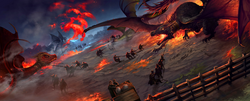
Dragonologists transporting dragons across a vast distance
Draco Malfoy's first name came from the constellation The Dragon ("Draco" in Latin). The motto of Hogwarts School of Witchcraft and Wizardry was Draco dormiens numquam titillandus; Latin for Never tickle a sleeping dragon.
The Hogwarts gamekeeper, Rubeus Hagrid, loved and adored dragons, briefly owning a Norwegian Ridgeback named Norbert, who turned out to be a female and was subsequently renamed Norberta.[2] In 1993, the Minister for Magic, Cornelius Fudge, suggested placing dragons to guard the school, after being compelled to remove the Dementors, something that Professor Dumbledore thought Hagrid would be very happy with.[11]

A Ukrainian Ironbelly guarding high security vaults at Gringotts
Many useful materials came from dragons, but they were hard to obtain (see Uses below). It took almost half a dozen wizards just to stun a dragon.[12] Muggles believe that dragons are a mere myth, but have been known on occasion to glimpse these beasts. To prevent them from being seen by Muggles, and to protect them from poaching, dragons were kept in dragon reserves around the world, most of which were far from human habitation. Dragons couldn't be domesticated, despite individuals trying to do so.[1] However, it was possible to condition them via torture to make them somewhat subservient, as Gringotts Wizarding Bank had done to the one guarding the lower vaults, who had been trained to expect pain upon hearing a certain noise.[13] The selling of dragon products was closely regulated by the British Ministry of Magic, and only dragon species that were over-breeding were killed to make these items. Those who studied dragons were known as dragonologists.[8]
A dragon was mentioned in a song heard by Newt Scamander and his friends at the speakeasy known as the Blind Pig in 1926 New York. Also, the curse Fiendfyre produced flames in the shape of dragons,[14] and Gringotts Bank employed dragon feeders. The position included fireproof robes and paid 7 Galleons per week.
Uses
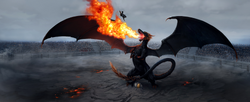
Harry Potter faces a Hungarian Horntail during the first task of the Triwizard Tournament
Dragons were used in the First Task of the Triwizard Tournament of 1994, in which the champions had to retrieve a golden egg from a nesting mother. The varieties used were: the Hungarian Horntail, the Chinese Fireball, the Swedish Short-Snout, and a Welsh Green.[15] Ron Weasley's brother Charlie worked with dragons in Romania at the time, and helped transport the dragons used in the Tournament.[12] Dragons were also used to guard certain vaults at Gringotts Wizarding Bank, and one was used by Harry Potter, Ron Weasley and Hermione Granger to escape the bank following their break-in in 1998.[13]
Though they couldn't be domesticated, there was one known instance of a dragon being used as a mount. In May 1998, Harry Potter, Ron Weasley, and Hermione Granger rode on the back of a dragon,[13] though they had trouble maintaining a grip on their steed, and could not control its flight.[16] During the 1993–1994 school year, before playing in the Quidditch final against Slytherin, Harry dreamed that the Slytherin team were flying on dragons instead of broomsticks. When he awoke he realised that they would not be allowed to ride dragons.[17]
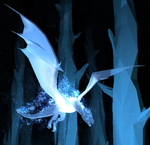
A Patronus Charm cast in the corporeal form of a dragon
The dragon model, like the model in the First Task of Triwizard Tournament of 1994,[15] was used in a roast chestnuts sale, near Weasleys' Wizard Wheezes, in Diagon Alley to hold the chestnut in place.[18]
Dragon milk could be used to create dragon milk cheese, as noted in the revised edition of Charm Your Own Cheese.[8]
Madam Rosmerta owned a silk dressing gown embroidered with dragons, which she was wearing on the night in June 1997 when Harry Potter and Albus Dumbledore apparated back from the Crystal Cave.[19]
There was also a disease called the Dragon Pox in the wizarding world, which was named after the dragon.[7]
In rare cases, a corporeal Patronus might take the form of a dragon.[7]
| Material | Use |
|---|---|
| Dragon blood | Albus Dumbledore discovered the twelve uses of dragon blood.[20] The twelfth use was as an oven cleaner.[21] Another one is spot remover.[22] Dragon blood was used in potions within the wizarding world.[7] [23] |
| Dragon claw | During the 1995–1996 school year, in the midst of the O.W.L.s, a trade sprang up among the fifth and seventh year students for various supposed brain stimulants. A student named Harold Dingle was offering powdered dragon claw, though Hermione Granger confiscated it, as it turned out to be dried Doxy droppings. Ron Weasley said that dragon claw did work and that it gave your brain a boost, making you cunning for a few hours, though it is not known if this was actually true.[24] |
| Dragon dung | Dragon dung was sold by the barrel in Knockturn Alley. It was a rich fertiliser used by students at Hogwarts in Herbology.[25] |
| Dragon eggs | Dragon eggs were classified as a Class A Non-Tradeable Material by the British Ministry of Magic.[1] Despite the ban, many dragon eggs could still be found on the black market. Chinese Fireball egg shells were highly prized as potion ingredients by Chinese witches and wizards. |
| Dragon heart | Dragon heartstring was an exceptionally powerful, and one of the most common kinds of core used in wands.[26] |
| Dragon horn | Powdered dragon horn was used in many potions. Romanian Longhorn Horns were listed as a Class B-Tradable Material by the British Ministry of Magic.[1] |
| Dragon hide | Dragon hide was used to make clothing. Where Muggles would wear leather, wizards wore dragon hide. The skin was very tough, impervious to some spells, and provided the same physical protection as leather, while at the same time having the same texture and appearance as snake skin. Dragon hide was used to make gloves, boots, jackets and shields. In high demand at the moment was the skin of the Swedish Short-Snout. Fred and George Weasley wore dragon skin jackets when they greeted Harry after his fifth school year.[27] Professor Horace Slughorn had a dragon-skin briefcase, with gold clasps.[28] When Rubeus Hagrid and Olympe Maxime went to be emissaries to the giants, on Albus Dumbledore's behalf, they brought a roll of dragon skin as a gift for the Gurg.[29] |
| Dragon liver | Dragon liver was sixteen Sickles an ounce, and was often used as an ingredient for potions.[30] [31] |
| Dragon meat | When Hagrid returned from his trip to the giants with many injuries (actually acquired from his half-brother Grawp), he put a bloody, green-tinged, dragon meat steak, slightly larger than an average car tire, on his face as it helped the stinging. It is not known if dragon meat was safe for humans to eat but seemed fine for canines.[29] |
Books
- "Tried and tested tips to help you breed dragons, including the old-time favourite of brandy and chicken blood every half hour for newly-hatched chicks."
- — Dragon Breeding for Pleasure and Profit [src]
Spells that affected dragons
- "Dragons are extremely difficult to slay, owing to the ancient magic that imbues their thick hides, which none but the most powerful spells can penetrate..."
- — A Hogwarts Library book[src]
While dragon skin could resist most spells, such as a single Stunning Spell, certain strategies might be employed to circumvent the strength of their hides.
| Spell | Effect |
|---|---|
| Conjunctivitis Curse | While dragons resisted most spells due to their hide, their eyes were their weakest point, and as such, the Conjunctivitis Curse, which caused irritation in the eyes, remained effective towards them. In the Triwizard Tournament of 1994, Durmstrang champion Viktor Krum used this curse on a dragon, with satisfying results.[15] |
| Stunning Spell | Like most creatures with spell resistance, the use of multiple spells at once could override their immunity. In the Triwizard Tournament of 1994, Charlie Weasley and several other dragonologists used multiple Stunning Spells to successfully subdue several dragons.[12] |
| Bewitched sleep | Fleur Delacour succeeded in putting a Common Welsh Green into a trance during the Triwizard Tournament.[15] |
Dragon reserves
Known breeds
- "There was a silvery blue one with long, pointed horns, snapping and snarling at the wizards on the ground, a smooth-scaled green one, which was writhing and stamping with all its might, a red one with an odd fringe of fine gold spikes around its face, which was shooting mushroom-shaped fire clouds into the air, and a gigantic black one, more lizard-like than the others, which was nearest to to them."
- — Physical descriptions of different breeds[src]
There was no officially sanctioned breeding of dragons, as dragon breeding was outlawed by the Warlocks' Convention of 1709. However, they had been known to interbreed, producing rare hybrids. Below is a list of the ten known pure-bred breeds of dragons according to the fifty-second edition of Fantastic Beasts and Where to Find Them:
| Breed | Image | Description |
|---|---|---|
| Antipodean Opaleye | 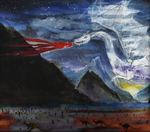 | Native to New Zealand, the Opaleye was generally considered one of the most beautiful dragons, with pearly scales that lined its body, and glittering multi-coloured eyes that had no pupils.[1] |
| Chinese Fireball (known as "Lion Dragon") |  | The Fireball was scarlet and smooth scaled with a fringe of golden spikes around its snub-snouted face and extremely protuberant eyes.[1] |
| Common Welsh Green (a native dragon of Great Britain) | 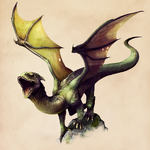 | The common Welsh was green in colour and with two spiked horns that resided on top of its head. The tail was vert stream-line with a single pointed tip at the end.[1] |
| Hebridean Black (the other native dragon of Great Britain) | 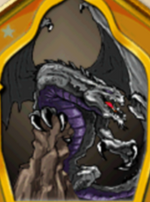 | It had dark rough scales, ridges along its back, and a tail tipped with an arrow-shaped spike. The Hebridean Black had brilliant purple eyes and could grow to be up to thirty feet long.[1] |
| Hungarian Horntail (considered to be the most dangerous dragon) | 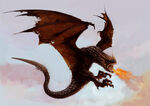 | It had black scales, and was lizard-like in appearance. It also had yellow eyes, bronze horns and similarly coloured spikes that protruded from its long tail.[1] |
| Norwegian Ridgeback |  | It resembled the Hungarian Horntail, except for the black ridges on its back, the browner texture in its scales. |
| Peruvian Vipertooth (a highly venomous dragon) | 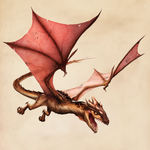 | Its scales were smooth and copper-coloured. It also had black ridge-markings and short horns on its head.[1] |
| Romanian Longhorn | 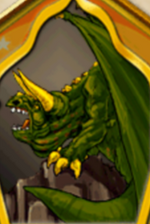 | The Romanian Longhorn had dark green scales, and two long, glittering golden horns.[1] |
| Swedish Short-Snout | 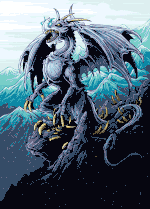 | The scales were silvery blue, and its powerful flame was also a brilliant blue colour — and hot enough to reduce timber and bone to ashes in seconds.[1] |
| Ukrainian Ironbelly (the largest dragon breed ever recorded) | 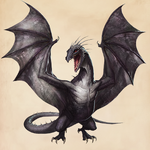 | It was a bipedal breed, metallic grey in colour, with an immense wingspan, long talons and rough scales said to be as hard as steel. It was the largest breed of dragon which reached up to six tonnes, and its eyes were deep red. Sometimes the eyes seemed to be the same colour as its body because of a protective scale.[1] |
The existence of these two dragons were only shown on a page of notes concerning the book Dragon Breeding for Pleasure and Profit.[32]
| Breed | Image | Description |
|---|---|---|
| Catalonian Fireball | 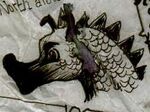 | It appeared to have a black or possibly scorched, somewhat oddly shaped snout and possessed a row of spikes that descended down its neck. Two black horns resided on the top of its head. |
| Portuguese Long-Snout |  | Its appearance was somewhat similar to that of the Catalonian Fireball, with ridged neck and scaly hide, but with a longer snout and pointier horns. |
Behind the scenes
- Dragons exist in the legends of many cultures worldwide. The dragons of Harry Potter bear the most resemblance to the modern European dragon in that they fly, breathe fire, and have magically powerful blood.
- Draco Malfoy's first name, Draco, is Latin for both "snake" and "dragon".
- In the film adaptation of Harry Potter and the Order of the Phoenix, Fred and George Weasley have a firework dragon chase Dolores Umbridge through the Great Hall.
- Most of the dragons in the films don't have front legs and have the posture of a bat or a pterosaur.
- The Catalonian Fireball appears to be an early draft on the Chinese Fireball because these were notes for Dragon Breeding for Pleasure and Profit on J. K. Rowling's official site. The same for the Portuguese Long-Snout which seems to be an early draft for the Romanian Longhorn and the Swedish Short-Snout.
- In the credits of the film adaptation of Harry Potter and the Goblet of Fire, it says "No Dragons were harmed in the making of this movie". This probably refers to the scene in the film where the Hungarian Horntail falls off the bridge and presumably dies.
Appearances
![]()
The Harry Potter Wiki has 209 images related to Dragon .
- Harry Potter and the Philosopher's Stone (First appearance)
- Harry Potter and the Philosopher's Stone (film)
- Harry Potter and the Philosopher's Stone (video game)
- Harry Potter and the Chamber of Secrets (Mentioned only)
- Harry Potter and the Chamber of Secrets (film) (Mentioned on a wood panel in Flourish and Blotts)
- Harry Potter and the Chamber of Secrets (video game) (Appears as statue)
- Harry Potter and the Prisoner of Azkaban (Mentioned only)
- Harry Potter and the Prisoner of Azkaban (film) (Mentioned only)
- Harry Potter and the Prisoner of Azkaban (video game) (Appears in PC and console versions)
- Harry Potter and the Goblet of Fire
- Harry Potter and the Goblet of Fire (film)
- Harry Potter and the Goblet of Fire (video game)
- Harry Potter and the Order of the Phoenix (Mentioned only)
- Harry Potter and the Order of the Phoenix (film) (Appears as Fireworks)
- Harry Potter and the Order of the Phoenix (video game) (Mentioned only)
- Harry Potter and the Half-Blood Prince (Mentioned only)
- Harry Potter and the Half-Blood Prince (film)
- Harry Potter and the Deathly Hallows
- Harry Potter and the Deathly Hallows: Part 1 (video game)
- Harry Potter and the Deathly Hallows: Part 2
- Harry Potter and the Deathly Hallows: Part 2 (video game)
- Harry Potter and the Cursed Child
- Harry Potter and the Cursed Child (play)
- Fantastic Beasts and Where to Find Them: The Original Screenplay (Mentioned only)
- Fantastic Beasts and Where to Find Them (film) (Mentioned only)
- Fantastic Beasts: The Crimes of Grindelwald - The Original Screenplay (Mentioned only)
- Fantastic Beasts: The Crimes of Grindelwald (Mentioned only) [33]
- Fantastic Beasts and Where to Find Them
- Quidditch Through the Ages (Mentioned only)
- The Tales of Beedle the Bard: Illustrated Edition
- Pottermore (Mentioned only)
- Wizarding World (Mentioned only)
- Harry Potter: A Pop-Up Book
- LEGO Harry Potter
- LEGO Harry Potter: Building the Magical World
- LEGO Harry Potter: Characters of the Magical World
- LEGO Harry Potter: Years 1-4
- LEGO Harry Potter: Years 5-7
- LEGO Dimensions
- Harry Potter and the Forbidden Journey
- Harry Potter: The Character Vault (Mentioned only)
- Harry Potter: The Creature Vault
- Harry Potter Trading Card Game
- Harry Potter for Kinect (Mentioned only)
- Wonderbook: Book of Spells
- Wonderbook: Book of Potions
- Fantastic Beasts: Cases from the Wizarding World
- Harry Potter: Hogwarts Mystery
- Harry Potter: Wizards Unite
- Harry Potter: Puzzles & Spells
- Harry Potter: Magic Awakened
- Hogwarts Legacy
Notes and references
- ↑ 1.00 1.01 1.02 1.03 1.04 1.05 1.06 1.07 1.08 1.09 1.10 1.11 1.12 1.13 1.14 1.15 1.16 1.17 1.18 1.19 1.20 1.21 1.22 1.23 1.24 1.25 1.26 1.27 1.28 1.29 1.30 1.31 1.32 Fantastic Beasts and Where to Find Them
- ↑ 2.0 2.1 2.2 2.3 2.4 2.5 2.6 2.7 2.8 Harry Potter and the Philosopher's Stone, Chapter 14 (Norbert the Norwegian Ridgeback)
- ↑ Harry Potter: Wizards Unite
- ↑ Quidditch Through the Ages, Chapter 2 (Ancient Broom Games)
- ↑ (see this image)
- ↑ Fantastic Beasts: Cases from the Wizarding World
- ↑ 7.0 7.1 7.2 7.3 Pottermore
- ↑ 8.0 8.1 8.2 J. K. Rowling's official site
- ↑ Given the fact that dragons produced milk in the first place, that this mixture was the first thing a newborn dragon consumed, as well as the fact that dragons obviously couldn't make brandy, it appeared this was a wizarding replacement for dragon milk used to feed newborn dragons.
- ↑ Fifth question of the third W.O.M.B.A.T. at J. K. Rowling's official site
- ↑ Harry Potter and the Prisoner of Azkaban, Chapter 22 (Owl Post Again)
- ↑ 12.0 12.1 12.2 Harry Potter and the Goblet of Fire, Chapter 19 (The Hungarian Horntail)
- ↑ 13.0 13.1 13.2 Harry Potter and the Deathly Hallows, Chapter 26 (Gringotts)
- ↑ Harry Potter and the Deathly Hallows, Chapter 31 (The Battle of Hogwarts)
- ↑ 15.0 15.1 15.2 15.3 Harry Potter and the Goblet of Fire, Chapter 20 (The First Task)
- ↑ Harry Potter and the Deathly Hallows, Chapter 27 (The Final Hiding Place)
- ↑ Harry Potter and the Prisoner of Azkaban, Chapter 15 (The Quidditch Final)
- ↑ Harry Potter and the Half-Blood Prince (film)
- ↑ Harry Potter and the Half-Blood Prince, Chapter 27 (The Lightning-Struck Tower)
- ↑ Harry Potter and the Philosopher's Stone, Chapter 6 (The Journey from Platform Nine and Three-Quarters)
- ↑ Quote from J.K. Rowling interview with the San Francisco Chronicle
- ↑ Interview with Steve Kloves
- ↑ Harry Potter and the Philosopher's Stone, Chapter 16 (Through the Trapdoor)
- ↑ Harry Potter and the Order of the Phoenix, Chapter 31 (O.W.L.s)
- ↑ Harry Potter and the Chamber of Secrets, Chapter 6 (Gilderoy Lockhart)
- ↑ Harry Potter and the Goblet of Fire, Chapter 18 (The Weighing of the Wands)
- ↑ Harry Potter and the Order of the Phoenix, Chapter 38 (The Second War Begins)
- ↑ Harry Potter and the Half-Blood Prince, Chapter 18 (Birthday Surprises)
- ↑ 29.0 29.1 Harry Potter and the Order of the Phoenix, Chapter 20 (Hagrid's Tale)
- ↑ Harry Potter and the Philosopher's Stone, Chapter 5 (Diagon Alley)
- ↑ The price in the older versions of the novel was given as seventeen Sickles, but this was changed because seventeen Sickles is equal to one Galleon, so it would be like saying "One hundred cents".
- ↑ here
- ↑ / Crimes of Grindelwald
| Magical Creatures by classification | |
|---|---|
| X | Flobberworm · Horklump |
| XX | Augurey · Bowtruckle · Chizpurfle · Clabbert · Diricawl · Fairy · Ghoul · Gnome · Grindylow · Imp · Jobberknoll · Mooncalf · Porlock · Puffskein · Ramora · Winged horse |
| XXX | Ashwinder · Billywig · Bundimun · Crup · Doxy · Dugbog · Fire crab · Fwooper · Glumbumble · Hippocampus · Hippogriff · Hodag · Jarvey · Knarl · Kneazle · Leprechaun · Lobalug · Mackled Malaclaw · Moke · Murtlap · Niffler · Nogtail · Pixie · Plimpy · Pogrebin · Red Cap · Salamander · Sea serpent · Shrake · Streeler · Winged horse |
| XXXX | Centaur · Demiguise · Erkling · Erumpent · Golden Snidget · Graphorn · Griffin · Hidebehind · Kappa · Kelpie · Merpeople · Occamy · Phoenix · Re'em · Runespoor · Snallygaster · Sphinx · Tebo · Thestral · Thunderbird · Troll · Unicorn · Winged horse · Yeti |
| XXXXX | Acromantula · Basilisk · Chimaera · Dragon · Horned Serpent · Lethifold · Manticore · Nundu · Quintaped · Wampus cat · Werewolf |
How To Get A Dragon Patronus
Source: https://harrypotter.fandom.com/wiki/Dragon
Posted by: bourgaultadind1951.blogspot.com

0 Response to "How To Get A Dragon Patronus"
Post a Comment